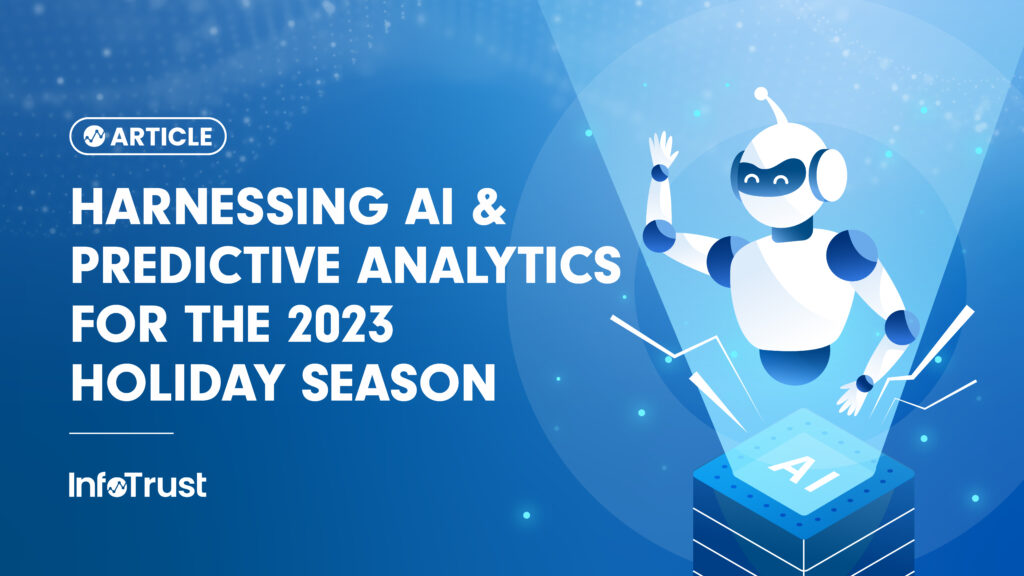Advancements in AI in 2023 have made it possible for brands to unlock many benefits, from greater efficiencies to deeper insights to media optimization. For many of our B2C partners at InfoTrust, the holiday season can make or break their performance for the year. Here are some ways we’re seeing our partners leverage AI and predictive analytics as part of their digital marketing strategy this holiday season to meet their year-end goals.
Predictive Audiences
Predictive audiences help businesses identify customers who are likely to convert based on relevant characteristics, such as their product preferences and spending habits. Predictive audiences are a great holiday strategy because:
- They are a proactive approach that anticipates how different segments of your customers will behave.
- They enable your marketing team to stay top of mind with customers during this busy time of the year by sending personalized messaging.
- They can help with acquiring lookalike customers of high value.
- They can help optimize the cost of acquisition.
What’s more, when you use capabilities like customer match, you have durable, cookie-free targeting that enables marketers to deliver targeted campaigns to audiences at scale and in a cost-effective way.
Common predictive audiences and types of predictive audiences that can be considered for your marketing strategy:
- Propensity modeling can be used for your retargeting efforts to drive any type of conversion.
- Customer lifetime value can help in retargeting, as well as the acquisition of new customers. Additionally, it can help in nurturing customer relationships at different stages of the customer lifecycle.
- Time to reorder solutions that can enable marketers to reach customers when they’re likely to make their next purchase. We advise using these audiences in the new year to strategically re-engage those customers who purchased during the holiday season.
- Churn modeling can help prevent churn, as well as help marketers identify customers who have likely churned so that they are no longer included in campaigns.
Automatically-Created Assets Using Generative AI
Advertisers in Google Ads can use automatically-created assets to generate the headlines and descriptions of Search ads based on content from landing pages and existing ads. This reduces the time required for the creation of new assets and allows advertisers to scale ads that are personalized to the user’s query. Greater personalization leads to higher ad relevance and better performance as Ads will automatically remove assets that are not performing well or that are out of sync with the source material.
Incorporating generative AI further into Search and specifically automatically-created assets is an area of active development for Google. New features are coming soon that will allow for more adaptability of ads based on the context of the user’s query.
Forecasting
Forecasting is a way of predicting what will happen in the future so that your business can make better decisions in the present. Forecasting can add value across an organization, especially during the holiday period:
- The marketing team can use forecasts to understand if they are on track to meet their sales targets or if they need to pivot their strategy.
- Forecasting can be used to predict revenue and other KPIs, as well as help predict the sales of a single product or multiple products at the same time.
- Additionally, forecasts can be set up as per business needs to show monthly, weekly, or hourly forecasts, with the main goal being to provide the business with the ability to take a very nimble approach to acting on their sales or campaign strategy.
Some of the common problems that forecasting can help businesses with is to respond quickly to current-day trends in order to optimize on their campaigns in real time, which can help them meet important sales targets. Businesses that have physical warehouses can be informed of huge spikes in sales so that they’re better enabled to manage inventory. Overall, forecasting enables greater agility and provides a proactive approach to optimizing your sales and marketing strategy.
AI-Powered Creative Analysis
The widespread availability of AI tools for understanding language, images, and video gives marketers the ability to analyze their creative assets in new ways. Whereas predictive audiences and other targeting approaches built on first-party user data are one way to optimize media in the new privacy landscape, AI-powered creative analysis drives media optimization without relying on personal data. Instead, marketers can use AI tools to thoroughly categorize and describe their creatives at scale and then run machine learning models to understand which elements of the creative are associated with the best ad performance. These insights are critical for brands that:
- Invest heavily in Display and Video, as these formats are expensive to produce
- Due to the nature of their industry, have limited ability to collect first-party data
- Are already greatly impacted by privacy changes
Learnings from the AI-powered creative analysis are then used to understand which ad elements are resonating best with users to guide future creative strategy and decisions.
Regression-Based Attribution
Regression-based attribution can help marketers understand the impact of their marketing tactics and provide insights into how their campaigns may behave in the future (which enables future planning and optimization). We all see that the digital ecosystem is evolving, especially with updates to user privacy laws, browser changes, and other regulations, which limit marketers’ ability to connect with customers. To adjust to this changing landscape, we advise that companies invest in their own first-party data, make sure that they have durable tagging in place, and start transitioning to attribution models that do not rely on third-party cookies. This is where regression-based attribution comes in as it provides a durable approach to attribution (unlike multi-touch attribution).
Regression-based attribution helps businesses answer the following questions:
- How do we attribute digital media to offline as well as online sales with cookie deprecation?
- How do we continue to understand the contribution of one marketing tactic versus the other?
In addition to providing the typical insights of an attribution model, like attributed conversions, the regression-based attribution model can be used for scenario planning to help you optimize your campaigns. You can forecast the impact of making changes to your media budgets across tactics and find opportunities for improvement in your current strategy. We advise using these insights to run tests to objectively measure the lift in ROI from these optimizations.
Final Thoughts
We’ve seen a great deal of excitement this year surrounding AI and predictive analytics, and there are numerous use cases and opportunities for brands to realize the value of these new tools and techniques across their digital marketing teams. We advise our partners on taking advantage of AI and predictive analytics at each stage of the campaign lifecycle: predictive audiences and automatically-created assets are used during campaign planning and set up, forecasting is used to provide better visibility once campaigns are in flight, and AI-powered creative analysis and regression-based attribution are used after campaigns have ended to understand performance and uncover the insights that guide next steps.



